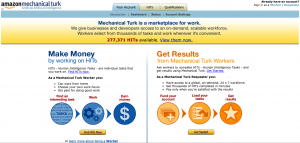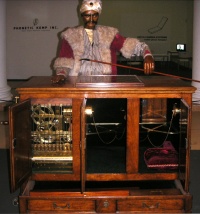Difference between revisions of "Mechanical Turk"
| Line 41: | Line 41: | ||
Workers set their own hours and only complete the HITs that appeal to them. Because workers can complete and many or as little tasks as they choose, they are considered paid contractors, rather than paid employees, in the eye of the law. This caveat means that requestors do not have to file tax forms or pay payroll taxes, thus avoiding laws such as minimum wage, compensation, and overtime. Workers report their income as self-employment income when filing taxes. The average wage of an MTurk worker is about $1.00/hour, or approximately a few cents for each tasks <ref>http://www.utne.com/science-and-technology/amazon-mechanical-turk-zm0z13jfzlin.aspx</ref> | Workers set their own hours and only complete the HITs that appeal to them. Because workers can complete and many or as little tasks as they choose, they are considered paid contractors, rather than paid employees, in the eye of the law. This caveat means that requestors do not have to file tax forms or pay payroll taxes, thus avoiding laws such as minimum wage, compensation, and overtime. Workers report their income as self-employment income when filing taxes. The average wage of an MTurk worker is about $1.00/hour, or approximately a few cents for each tasks <ref>http://www.utne.com/science-and-technology/amazon-mechanical-turk-zm0z13jfzlin.aspx</ref> | ||
| − | + | Requestors can post a large variety of HITs for workers to complete. Requestors can also have workers fill out questionnaires or complete tests to verify certain qualifications. If they feel that the task performed by a worker does not meet certain qualifications or standards, requestors can reject the work completed by the worker. In each description of the HIT, requestors much specify how much they are paying for each HIT, how many workers they want for each HIT, and how much time the worker will have to complete the HIT once they begin <ref>https://requester.mturk.com/</ref>. | |
===Uses=== | ===Uses=== | ||
| + | MTurk created a large platform where many people can work on the same task in parallel. The importance of MTurk is that is allows businesses and individuals to crowdsource work that is better done by a human rather than a computer. Below are some of the major categories of HITs that are posted on Mechanical Turk. | ||
====Processing photos/videos==== | ====Processing photos/videos==== | ||
====Data cleaning/verification==== | ====Data cleaning/verification==== | ||
Revision as of 20:06, 18 February 2016
|
Contents
Etymology
The name Mechanical Turk comes from the 18th century chess-playing automaton, which was named "The Turk". The Turk was created by Wolfgang von Kempelen in 1770 in Austria. The machine appeared to be able to play a strong game of chess against any human opponent, even beating Napoleon Bonaparte and Benjamin Franklin on its tour of Europe [1]. It wasn't until the early 1820s that the Turk was exposed as an elaborate hoax. There machine was designed so a human chest master could sit hidden within the cabinet under the board and control the movements of the humanoid dummy [2]. The Turk machine is what inspired the name for Amazon's crowdsourcing tasks website. Just as the Turk needed the human chess master to properly function, MTurk provides opportunities for workers to perform tasks that modern machines are unable to complete.
History
Prior to its public launch, MTurk was created by Peter Cohen for use within the Amazon company. The original function of MTurk was to find duplicate webpages describing the same product on Amazon.com and to categorize all the the various product pages. Using software and algorithms to eliminate all duplicates across thousands of different data sets would be practically impossible. Amazon needed human intelligence to perform this daunting task, and more specifically, they needed a way to create a community of workers who could work together in parallel [3]. Peter Cohen, who was the director of Amazon Web Services during this time, led MTurk from idea to launch [4].
Peter quickly realized that many companies had daunting tasks that humans could do better than computers, thus deciding to make it a public marketplace. MTurk was launched publicly on November 2, 2005 as a place where businesses with work and people looking to do work could find each other.
By March of 2007, the MTurk workforce contained over 100,000 workers from over 100 countries. The site continued to grow exponentially and by January of 2011, there were over 500,000 workers from 190 different countries [5]
Originally, the Amazon MTurk service was launched as an API-only product platform. Amazon quickly realized that programmers and developers were not the only people who needed access to this on-demand, scalable workforce. Today, workers and requestors can visit the MTurk service via an internet website platform, API, and Command Line Tool [6]
Description of Service
Users
There are two types of MTurk users: Workers (employees) and Requestors (employers).
Workers set their own hours and only complete the HITs that appeal to them. Because workers can complete and many or as little tasks as they choose, they are considered paid contractors, rather than paid employees, in the eye of the law. This caveat means that requestors do not have to file tax forms or pay payroll taxes, thus avoiding laws such as minimum wage, compensation, and overtime. Workers report their income as self-employment income when filing taxes. The average wage of an MTurk worker is about $1.00/hour, or approximately a few cents for each tasks [7]
Requestors can post a large variety of HITs for workers to complete. Requestors can also have workers fill out questionnaires or complete tests to verify certain qualifications. If they feel that the task performed by a worker does not meet certain qualifications or standards, requestors can reject the work completed by the worker. In each description of the HIT, requestors much specify how much they are paying for each HIT, how many workers they want for each HIT, and how much time the worker will have to complete the HIT once they begin [8].
Uses
MTurk created a large platform where many people can work on the same task in parallel. The importance of MTurk is that is allows businesses and individuals to crowdsource work that is better done by a human rather than a computer. Below are some of the major categories of HITs that are posted on Mechanical Turk.
Processing photos/videos
Data cleaning/verification
Information Collection
Data Processing
Ethical Implications
asdf [9]
See Also
External Links
References
- ↑ SCHAFFER, Simon (1999), "Enlightened Automata", in Clark et al. (Eds), The Sciences in Enlightened Europe, Chicago and London, The University of Chicago Press, pp. 126-165.
- ↑ Ricky Jay, "The Automaton Chess Player, the Invisible Girl, and the Telephone", Jay's Journal of Anomalies, vol. 4 no. 4, 2000
- ↑ https://www.quora.com/What-is-the-story-behind-the-creation-of-Amazons-Mechanical-Turk
- ↑ https://www.linkedin.com/in/pecohen
- ↑ https://forums.aws.amazon.com/thread.jspa?threadID=58891
- ↑ https://www.quora.com/What-is-the-story-behind-the-creation-of-Amazons-Mechanical-Turk
- ↑ http://www.utne.com/science-and-technology/amazon-mechanical-turk-zm0z13jfzlin.aspx
- ↑ https://requester.mturk.com/
- ↑ www.twitter.com


